When I was a student of Metalsmithing in the late 1960's, this was the
definitive textbook for silver- and goldsmiths. Prior to Untracht's book,
most metalsmithing books were either basic primers or pretty picture books
but few, if any, delved into many of the more esoteric techniques available
to the modern metalsmith. Oppi Untracht remedied that problem many times
over in this fine text.
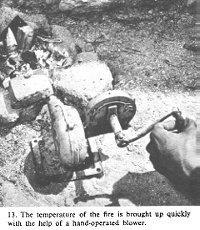
Oppi Untracht was a Fulbright Scholar in both India and Nepal from 1957 to
1959 and 1963 to 1965 respectively, and during those stays he visited many
metalsmiths, studied their art and took copious photographs of their work.
Much of what he learned in India and Nepal is included in this book,
including filigree, enameling (his forté), niello, bidri, kuftgari and
others. The majority of the illustrations for this volume appear to
originate with Untracht's eastern sojourns, and the scenes of craftsmen
producing magnificent works using the most primitive of techniques and tools
are truly fascinating.
Color photo of same blower still made today.
Image courtesy Bison Forge, New Deli, India.
While some of the techniques may have originated centuries ago and thousands
of miles away, Untracht details the processes sufficiently for the craftsman
to become familiar enough with each technique to pursue further
experimentation and learning. This exposure to the techniques of a culture
other than one's own can be both intriguing and educational, but the real
strength of Untrachts's book lies in his clear explanations of techniques,
starting with the most fundamental and progressing to the more advanced and
sometimes even arcane techniques that can take dedicated students years to
master.
 Beginning with an overview of the process of manufacturing the metal itself,
from ore to final rolling, Untracht provides some of the history and
metallurgy connected with the materials commonly used by artist metalsmiths.
The chemistry, physics and folklore of the metals are covered in the
beginning of the book, and several charts are provided at the end of the
book giving the physical properties of metals, drill sizes, chemical
formulae, etc. In looking over my copy of this book in preparation for this
review I was interested to note that the appendix pages bore much evidence
of repeated use over the past thirty or more years. Indeed, I doubt that
more than a week or two goes by that I do not find myself pulling down this
volume to verify a fact or confirm a theory.
Beginning with an overview of the process of manufacturing the metal itself,
from ore to final rolling, Untracht provides some of the history and
metallurgy connected with the materials commonly used by artist metalsmiths.
The chemistry, physics and folklore of the metals are covered in the
beginning of the book, and several charts are provided at the end of the
book giving the physical properties of metals, drill sizes, chemical
formulae, etc. In looking over my copy of this book in preparation for this
review I was interested to note that the appendix pages bore much evidence
of repeated use over the past thirty or more years. Indeed, I doubt that
more than a week or two goes by that I do not find myself pulling down this
volume to verify a fact or confirm a theory.
The book progresses in logical sequence from the simple techniques to the
more advanced, with clear and concise descriptions and illustrations more
than sufficient to allow the student or artist to learn the material. The
tools, the techniques and the aesthetics are all covered in adequate detail
to allow the student to progress naturally and comfortably from one level to
the next, while ample material is provided for the advanced metalsmith to
foster entirely new explorations in metal. And, while the main thrust of
the book is clearly geared toward the jeweler/artist/metalsmith, there are
chapters on forging, welding, spinning and fabrication techniques that apply
to steel and iron as much as to silver and gold.
The well-rounded metalsmith will have a command of many techniques outside
his own immediate field or he will find himself constrained to such a narrow
venue that it soon becomes stifling. Knife makers use many of the
techniques of jewelers in the fitting of furniture to their blades, many
blacksmiths employ non-ferrous metals for accent or special purpose in their
iron works, and armourers and re-enactors often find themselves in need of
techniques borrowed from silversmiths.
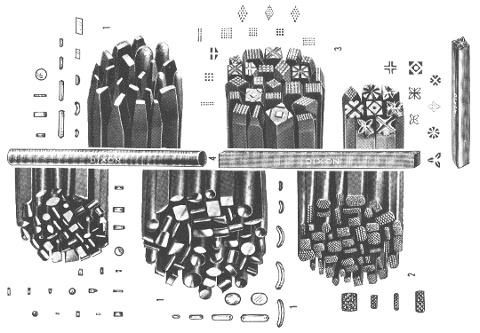
Page 96, Dixon catalog illustration of chasing tools.
I am frequently asked for a recommendation for a good book covering the
subject of non-ferrous metalsmithing techniques; this is the one book that I
unhesitatingly recommend, knowing that it is both broad in scope and
accurate in detail. Oppi Untracht's fine book is a worthy addition to any
metalsmith's library.
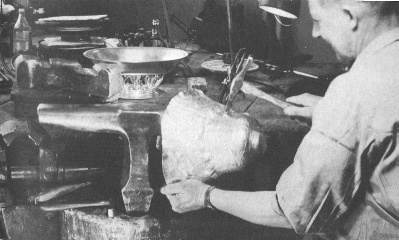
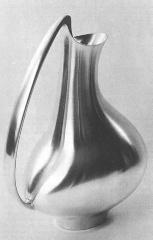 Silversmith raising a vessle designed by Henning Koppel. One of 13 step by step figures.
Silversmith raising a vessle designed by Henning Koppel. One of 13 step by step figures.
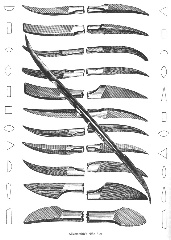
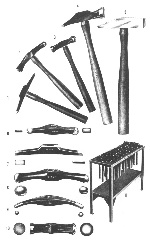 Examples of the many plates from the old William Dixon catalog reproduced in the book.
Examples of the many plates from the old William Dixon catalog reproduced in the book.
The William Dixon Company, which was established in 1868 and was located in Newark, New Jersey.
The William Dixon Company supplied tools to the jewelry, dental and optical industries.
In 1964, Grobet purchased the company.
The silversmiths files are labled "Glardon".
Glardon is a world renowned brand name for files produced by Usines
Metallurgiques de Vallorbe. This company, made up of Grobet, Glardon
and Borloz, the three principal manufacturers in the region at that time,
was formed in 1899 to expand their sales of files well beyond the Swiss border.
|

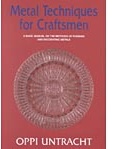 Published by:
Published by:






